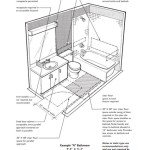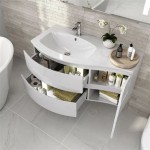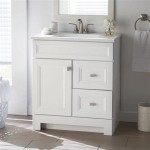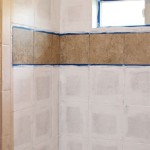How Do You Wire a Bathroom Exhaust Fan?
Proper bathroom ventilation is essential for maintaining a healthy and comfortable home environment. Exhaust fans effectively remove moisture, odors, and pollutants generated during showers and other activities. Installing an exhaust fan often involves electrical wiring, which requires careful planning and execution to ensure safety and functionality. This article provides a comprehensive guide on how to wire a bathroom exhaust fan, covering essential safety precautions, necessary tools, and detailed step-by-step instructions.
Before commencing any electrical work, prioritizing safety is paramount. Electrical shock poses a significant risk, and adherence to safety guidelines is non-negotiable. Disconnecting power to the circuit is the most critical safety precaution. Locate the appropriate circuit breaker that controls the bathroom's electrical supply and switch it to the "OFF" position. To confirm that the power is completely disconnected, use a non-contact voltage tester to verify that no electricity is flowing through the wires that will be handled. If a non-contact voltage tester is unavailable, a multimeter can be used to measure voltage; however, caution should be exercised when using a multimeter on live circuits if confirming the circuit is de-energized. Never work on electrical wiring without first ensuring the power is turned off at the source.
Beyond de-energizing the circuit, wearing appropriate personal protective equipment (PPE) is crucial. Rubber-soled shoes provide insulation against electrical shock, and safety glasses protect the eyes from debris and accidental electrical arcs. Additionally, using insulated tools, such as wire strippers, pliers, and screwdrivers, further minimizes the risk of electrical shock. Avoid working in damp or wet conditions, as water significantly increases the potential for electrical hazards.
It is important to check local electrical codes before beginning the wiring process. Electrical codes vary by region and jurisdiction and are in place to ensure safe and compliant electrical installations. Consulting local building authorities or a qualified electrician is advisable to understand the specific requirements applicable to the wiring of a bathroom exhaust fan in the given area. This proactive approach helps prevent potential code violations and ensures that the installation meets all safety standards.
Key Point 1: Gathering Necessary Tools and Materials
A successful exhaust fan wiring project requires having the right tools and materials readily available. This preparation streamlines the installation process and minimizes potential delays. The essential tools and materials include:
- New Bathroom Exhaust Fan: Select a fan with appropriate CFM (cubic feet per minute) rating for the bathroom size and features of a built-in light or heater.
- Non-Contact Voltage Tester: Needed to verify power is off.
- Wire Strippers: Used for removing insulation from electrical wires without damaging the conductor.
- Wire Connectors (Wire Nuts): Used to securely join electrical wires together. Sizes need to match the wires being connected.
- Pliers: For gripping, bending, and manipulating wires.
- Screwdrivers (Phillips and Flathead): Appropriate for the screws used in the electrical boxes and fan housing.
- Electrical Tape: For insulating and securing wire connections.
- Fish Tape (Optional): For pulling wires through walls or ceilings.
- Drill with appropriate drill bits: Used for creating pilot holes or mounting the fan housing.
- Electrical Cable (NM-B): Typically 14/2 or 12/2 with ground, depending on local electrical codes and circuit amperage. Check for the correct size.
- Electrical Boxes: For housing wire connections safely and securely.
- Cable Staples or Clamps: For securing electrical cable to studs or joists.
- Multimeter (Optional): For testing voltage and continuity.
- Safety Glasses: For eye protection.
- Rubber-Soled Shoes: For electrical insulation.
- Work Gloves: For hand protection.
Ensuring that all these items are on hand before beginning the wiring process contributes to a smoother and more efficient installation. It is also prudent to double-check that the selected fan unit is compatible with the existing electrical system in the bathroom, considering factors such as voltage and amperage requirements.
Key Point 2: Wiring the Fan: Step-by-Step Instructions
With the necessary preparations complete, the actual wiring of the exhaust fan can commence. The following steps outline the process, emphasizing precision and adherence to safety guidelines:
- Turn Off the Power: As emphasized earlier, the first and most crucial step is to de-energize the circuit breaker that supplies power to the bathroom. Verify that the power is off using a non-contact voltage tester.
- Prepare the Wiring at the Fan: Carefully remove the fan housing cover to access the wiring compartment. Locate the wires extending from the fan motor and any additional features, such as a light or heater. Typically, these wires will be black (hot), white (neutral), and green or bare copper (ground).
- Prepare the Power Supply Wiring: Locate the electrical box where the power supply wires will connect to the fan wires. Ensure that the power supply wires are also black (hot), white (neutral), and green or bare copper (ground). Strip approximately ¾ inch of insulation from the ends of each wire using wire strippers.
- Connect the Wires: Using wire connectors (wire nuts), connect the corresponding wires from the fan to the power supply wires. Twist the wires together tightly in a clockwise direction, then screw the wire connector onto the twisted wires until it is securely fastened.
- Connect the black (hot) wire from the fan to the black (hot) wire from the power supply.
- Connect the white (neutral) wire from the fan to the white (neutral) wire from the power supply.
- Connect the green or bare copper (ground) wire from the fan to the green or bare copper (ground) wire from the power supply.
- Secure the Connections: After making the wire connections, carefully tuck the wires into the electrical box, ensuring that they are not twisted or strained. Secure the electrical box cover or fan housing cover to protect the connections and prevent accidental contact with live wires.
- Grounding: Correct grounding is critical for safety. Ensure the ground wire from the fan is securely connected to the ground wire from the power source, and to the metal electrical box if present. This connection provides a path for stray electrical current, preventing shocks.
- Test the Fan: After completing the wiring, restore power to the circuit breaker. Turn on the exhaust fan to verify that it is functioning correctly. If the fan does not operate, immediately turn off the power and double-check all wiring connections.
If the exhaust fan has additional features, such as a light or heater, ensure that these are correctly wired according to the manufacturer's instructions. These features may require additional wires and connections.
Key Point 3: Addressing Common Wiring Scenarios and Challenges
While the basic wiring process remains consistent, specific scenarios and challenges may arise during the installation of a bathroom exhaust fan. Addressing these situations effectively ensures a safe and functional installation:
Replacing an Existing Fan: When replacing an existing fan, carefully disconnect the old fan's wiring and note the wire connections before removing the old unit. This provides a reference for wiring the new fan correctly. If the existing wiring is damaged or deteriorated, consider replacing it to ensure a safe and reliable connection.
Wiring a Fan with a Light or Heater: Fans with integrated lights or heaters require additional wiring connections. Typically, these units have separate wires for the fan motor, light, and heater. Follow the manufacturer's wiring diagram to connect these wires correctly to the appropriate power supply wires. It is important to ensure the circuit is rated to handle the additional load of a heater.
Wiring a Fan to a Three-Way Switch: In some cases, a bathroom exhaust fan may be wired to a three-way switch, allowing it to be controlled from two different locations. This requires a more complex wiring configuration that involves a three-way switch circuit. Consult an electrical wiring diagram or a qualified electrician for guidance on wiring a fan to a three-way switch.
Dealing with Damaged Wires: If any of the wires are damaged or frayed, they must be replaced to ensure a safe and reliable connection. Damaged wires can pose a fire hazard or cause the fan to malfunction. Use wire strippers to cut off the damaged sections and re-strip the wires to expose fresh conductor.
Troubleshooting Wiring Problems: If the fan does not operate after wiring, systematically check all connections, ensuring that they are secure and properly insulated. Use a multimeter to test for voltage at the fan wires to verify that power is reaching the unit. If problems persist, consult a qualified electrician for assistance.
Considerations for GFCI Protection: Depending on local electrical codes, a bathroom exhaust fan may need to be connected to a ground fault circuit interrupter (GFCI) protected circuit. GFCI outlets provide enhanced protection against electrical shock in wet or damp locations. Consult local codes to determine if GFCI protection is required for the exhaust fan circuit.
Conduit Use: Depending on local codes and the installation scenario, electrical wiring may need to be run through conduit for protection. This is particularly common in exposed locations or where wires are subject to physical damage. Use appropriate conduit fittings and connectors to ensure a secure and compliant installation.
Wiring a bathroom exhaust fan requires careful attention to detail and a strong commitment to safety. By following these guidelines and taking necessary precautions, individuals can safely and effectively install a bathroom exhaust fan, ensuring proper ventilation and a comfortable home environment.

Wiring Diagram For A Bathroom Exhaust Fan Switch Masterbathroomexhaustfan Light

Extractor Fan Wiring Diywiki

Exhaust Fan Wiring Diagram Single Switch

Bathroom Exhaust Fan With Humidity Sensor On One Switch Home Improvement Stack Exchange

Exhaust Fan Wiring Diagram Timer Switch

How To Wire A Bathroom Extractor Fan With Timer Home Electrical Wiring

Wiring Bathroom Exhaust Fan Light With Two Switches Doityourself Com Community Forums
Wire A Inline Exhaust Fan For Two Bathrooms
:strip_icc()/SCW_220_16-2d21c9c7c6b64ca889149b22f037fa24.jpg?strip=all)
How To Install A Bathroom Vent Fan For Mildew Free Space

How To Wire A Bathroom Extractor Fan With Timer Diy Doctor
Related Posts







